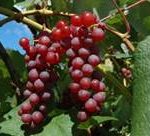Mid-August is approaching, and that means that fruit are beginning the ripening process in Vermont orchards and vineyards. This is an important time to plan some final management practices before things get too busy.
Foliar (apple) and petiole (grape) tissue sampling: Now is the time to collect plant tissue samples for nutrient analysis in apples and grapes to best tweak fertility programs next year. If you’re applying fertilizers without tissue samples, you are doing it blind. Samples collected every two, up to three years should be sufficient, unless you are noticing or correcting a particular deficiency. Samples should be collected separately by cultivar, rootstock, and planting system/block- basically, the sample should come from a uniform set of trees/vines. I’ve given instructions separately for grapes and apples in the past, and refer to those now if you need them. Each includes contact information for the appropriate labs that conduct the analyses and also provide important recommendations from them. As for timing, apples leaves are typically collected July 15 – August 15, and grapes at veraison, so we’re on-schedule to do both any time now.
Veraison signifies the beginning of the ripening process in grapes, and we have seen the beginnings of that process for the past few days at the UVM Hort Farm. This is an important time when nutrient flows are changing in the vine. It is especially important that grapes have good access to sunlight during ripening, so continue to position shoots and remove leaves around clusters. This is also a good time to find lagging clusters that are behind the main crop for ripeness and remove them to improve overall fruit quality. Diseased clusters may also be removed at this time.
Disease management remains important- in grapes, we have been seeing more powdery mildew on fruit than we like, and downy mildew and botrytis are also potential problems at this time. And eradicate application of stylet oil or oxidate may be appropriate on PM-infested grapes but only if you can get excellent, thorough coverage. Otherwise one last application of materials labeled against those diseases may be warranted before harvest.
In apples, we have had ample opportunity for infection from the whole range of summer disease: sooty blotch; flyspeck; black rot; bitter rot; etc. A final fungicide application may be warranted to keep fruit clean through harvest, and for wholesale packing orchards, an early September application may be needed on late-ripening cultivars.
ReTain application in apples: ReTain is a commercially available plant growth regulator that delays harvest, reduces drop, and potentially improves fruit quality in apples. It is applied three weeks prior to anticipated harvest, and has a 7-day preharvest interval. Growers should be thinking about their ReTain needs and scheduling in the coming days. Glen Koehler at University of Maine runs a useful model based on reported weather data for the UVM Hort Farm that may help consider when to apply this material in local orchards. Note: ReTain applications are expensive, and are best when carefully timed. I expect to forward some more detailed information in the coming week, so use this information only as a rough guide, and consider how your orchard environment may differ from ours.
“Preliminary McIntosh Harvest Date Forecasts
CAUTION: The estimates shown below are appropriate for long-term planning only. Harvest decisions should only be made on basis of direct orchard observations. Accuracy of these apple maturity estimates can vary between orchards and between years in a single orchard.
Harvest date estimates are based on temperature observations from the first 30 days after Full bloom. Estimates for this location are based on incomplete data until Tuesday, June 13.
To delay single pick harvest up to 7 to 10 days, apply ReTain 21 to 28 days prior to beginning of expected harvest date for untreated fruit.
To delay fruit maturity and improve storage potential of later picked apples (2nd, 3rd, 4th picks), apply ReTain 7 to 14 days prior to beginning of expected harvest date for untreated fruit. This later timing will not delay the start of harvest (1st pick), but will delay maturity for later picks.
Date to apply ReTain to delay first harvest for apples which without treatment would be ready for storage harvest on September 11 is from
Monday August 14 to August 21
Date to apply ReTain to delay maturity for 2nd, 3rd or 4th pick of those apples, without delaying start of harvest maturity, is from Monday, August 28 to September 4. Begin measuring actual McIntosh starch-iodine index no later than Thursday, August 24. The McIntosh maturity date estimate shown below is a preliminary, early-season forecast and in no way a substitute for starch index and other direct observations as harvest nears.
The Michigan formula estimates that non-spur McIntosh will reach starch index 4.0 and start the optimum harvest window for long term storage on Monday, September 11. Cornell Bulletin 221 provides formulas for different locations to estimate date when non-spur McIntosh not treated with ReTain will reach starch index 6.0 and the end of the optimum harvest window for long term storage. Using the Champlain Valley NY formula, McIntosh maturity is forecast to reach starch index 6.0 in South Burlington VT on Thursday, September 21.”
Where trade names or commercial products are used for identification,
no discrimination is intended and no endorsement is implied.
Always read the label before using any pesticide.
The label is the legal document for the product use.
Disregard any information in this message if it is in conflict with the
label.
The UVM Tree Fruit and Viticulture Program is supported by the
University of Vermont Agriculture Experiment Station, a USDA NIFA E-IPM
Grant, and USDA Risk Management Agency Funds.




